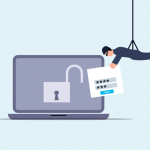
Ever since the first digital passwords came into existence, they have been a major source of Cybersecurity concerns. According to Finances Online, 81% of security incidents in 2022 happened due to stolen or weak passwords. Additionally, employees (and many employers) continue to neglect the basics of good cyber hygiene.
The main factors that make compromised credentials the main cause of data breaches: 61% of workers use the same password for multiple platforms, and 43% shared their passwords with others. Add to that the proliferation of weak, easily cracked passwords, and you might as well do one of two things:
1) Do away with security measures altogether. Why bother if you’re not serious about them?
– OR –
2) Get serious about them.
Largely due to the rise of the cloud, access and identity management have become a priority for many organizations. Another practice that needs to bite the dust is letting people access systems by entering only a username and password. Implement Multi-Factor Authentication (MFA).
Once a cybercriminal snags an employee’s login, they can access the account and any data that it contains – regardless of any defenses put in by your IT services. This is especially problematic when it’s an account like Microsoft 365 or Google Workspace, because the entirety of a company’s information is in there, and these accounts can access things like cloud storage and user email.
The smart money is on implementing conditional access – a major component of good Cybersecurity.
What is meant by Conditional Access?
Conditional access, also known as contextual access and context-aware access, is a method of controlling user access. Think of it as several ‘if/then’ statements wherein ‘if’ a certain thing is present, ‘then’ do this.
For example, conditional access allows you to set a rule that would state something like: ‘If a user is logging in from outside the country, then we should require a one-time-passcode.’ The same goes with any situation outside of the norm, like a strictly 9 to 5 worker attempting to login to the system remotely at midnight.
Conditional access allows you to add many conditions to the process of user access to a system. It is typically used hand-in-hand with MFA. This improves access security without unnecessarily inconveniencing users.
Some of the most common contextual factors used include:
IP address
Geographic location
Time of day
The device used
Role or group the user belongs to
Conditional access for Microsoft 365 can be set up in Azure Active Directory. It can also be set up in other identity and access management tools. It’s helpful to get the assistance of your IT support provider, especially if it’s a Managed IT Services provider rather than an hourly rate ‘IT consulting services Guy’. They can help with the setup and conditions that would make the most sense for your business.
Benefits of Conditional Access for Identity Management
Improved Security
Using conditional access allows you more flexibility in challenging user legitimacy. It doesn't just grant access to anyone with a username and password. Instead, the user needs to meet certain requirements.
Contextual access can block any login attempts from countries where none of your employees are. It can also present an extra verification question when employees attempt a login from an unrecognized device.
Automation of the Access Management Process
Once you have set up the ‘if/then’, the system knows what to do and takes it from there, automating the monitoring for contextual factors and taking the appropriate actions. This reduces the burden on administrative IT Services teams. It also ensures that no employee falls between the cracks.
Manual processes are always slower, less accurate, and less reliable than automated processes and also removes the human error factor, helping to ensure that each condition is being verified for every single login.
Enables Restrictions for Certain Activities
Conditional access isn’t just for keeping unauthorized users out of your accounts, it can also restrict the activities that legitimate users can do.
For example, you could restrict access to data or settings based on a user’s role in the system. For example, a loading dock foreman should not have access to the accounting departments data – no need for it. You can also use conditions in combinations such as lowering permissions to view-only. This can be triggered automatically if a user in a certain role logs in from an unknown device.
Better User Login Experience
Studies show that as many as 67% of businesses do not use multi-factor authentication, despite the fact that it’s one of the most effective methods to stop credential breaches.
The perception that it is inconvenient for employees is one of the main reasons it is not more widely used. Complain that it interferes with productivity or that it makes it harder to use their business applications are common.
At home, setting your alarm and locking your doors is inconvenient, so why not just leave those doors open as well? Then it would be as easy for crooks to steal your silverware and electronics as it would be for hackers to steal your data at the office.
When all is said and done, using conditional access together with MFA can improve the user experience. For example, you can require MFA only if users are working remotely. You can put in place extra challenge questions predicated on an employee’s role or base them on context. This keeps all users from being inconvenienced.
Enforces the Rule of Least Privilege
The best Cybersecurity practice is using the rule of least privilege, which means you only grant the lowest level of access in a system as necessary for a user to do their work. Once you have roles set up in your identity management system, you can base access on those roles.
Conditional access simplifies the process of restricting access to data or functions. You can base this on job needs, and it streamlines identity management because it contains all functions in the same system for access and MFA rules. Everything stays together, making management simpler.
Get Help Implementing Conditional Access Today
Once conditional access is set up, the automated system takes over. It improves your security and reduces the risk of an account breach. Contact us today for a free consultation to enhance your cybersecurity.
Frequently Asked Questions
Q: Does Google have conditional access?
A: Yes. Use ‘IAM Conditions’ to set up conditional access. Google provides a breakdown of how it works HERE.
Q: What is the difference between MFA and SCA?
A: For all intents and purposes, SCA (Strong Customer Authentication) is used in the EU, and sets requirements for payments and broader Open Banking and Open Data initiatives. The two terms can be used interchangeably, but the more common is MFA.
Q: Does Conditional Access override security defaults?
A: No, not automatically - but you will need to turn off security defaults before you can use Conditional Access policies. For Microsoft, if you have a plan or license that provides Conditional Access but haven't yet created any Conditional Access policies, using the security defaults is a good way to go.
Q: How does Conditional Access policy work?
A: In simple terms, conditional access policies are ‘if/then’ statements, if a user wants to access a resource, then they must complete an action. For example, if a payroll manager wants to access the payroll application, they are required to use multi-factor authentication to access it. Employees in unrelated departments, like sales, will not be allowed access (if set up correctly).
How secure is your network?
As a reputable member of the IT Support Los Angeles community since 2002, IT Support LA offers a FREE, no-risk network and security assessment. It is a non-intrusive scan that allows us to deliver a comprehensive report that is yours to keep. No strings, and no obligation to ever use our Managed IT Services.
The best defense is the best Cybersecurity to protect your data from theft, and a top-notch Managed Services Provider (MSP) to ensure continued reliability and defenses against newly emerging threats.
With our 100% Money Back Guarantee in writing, we offer a risk-free way for prospective clients to try us out. Because we do not require a ‘hard’ contract, our clients can fire us at any time with 30 days’ notice. We have to be good.
Need Mobile Device Security Solutions?
No matter what size company you have, mobile device management is vital. Contact us to learn more about our endpoint security solutions.
Among the Managed IT services we provide:
IT HelpDesk Service
Onsite IT Support
Cybersecurity
Cloud migration and management
Email migration services
Backup and disaster recovery
VoIP phone systems
IT disposition and recycling
Office moves
White label services (IT to IT)
IT Support LA an award-winning Managed Services Provider (MSP):
o 3 Years awarded Best IT by the Small Business Expo
o Awarded 2nd best company of any type in the US by the Small Business Expo SB100
o Awarded Best IT in California by Channel Futures
o Winner of Best IT in Los Angeles 2021 by Channel Futures
o Listed as one of the world’s Top 501 Managed Services Providers by CRN and in the top 250 in the ‘Pioneer’ listing
o 4 years listed as one of the Top 501 MSPs in the World by Channel Futures
o Globee 2021 Bronze Award winner for Chief Technology Officer of the Year
o Globee 2022 Gold Award winner for Chief Technology Officer of the Year
o Named one of 2022’s 50 ‘Best’ businesses in California by UpCity
o Named Best of IT winner for 2021 by UpCity
o Winner of Local Excellence Award for 2021 by UpCity
o Named Best of Cloud Consulting winner for 2021 by UpCity
o Certified as Top MSP and Cybersecurity Pro for 2021 by UpCity
o Named Best IT Support in Los Angeles for 2021 by Expertise.com.
For more information, or to receive your FREE no-risk network and Cybersecurity assessment, just fill out the form on this page or call us at:
818-805-0909


